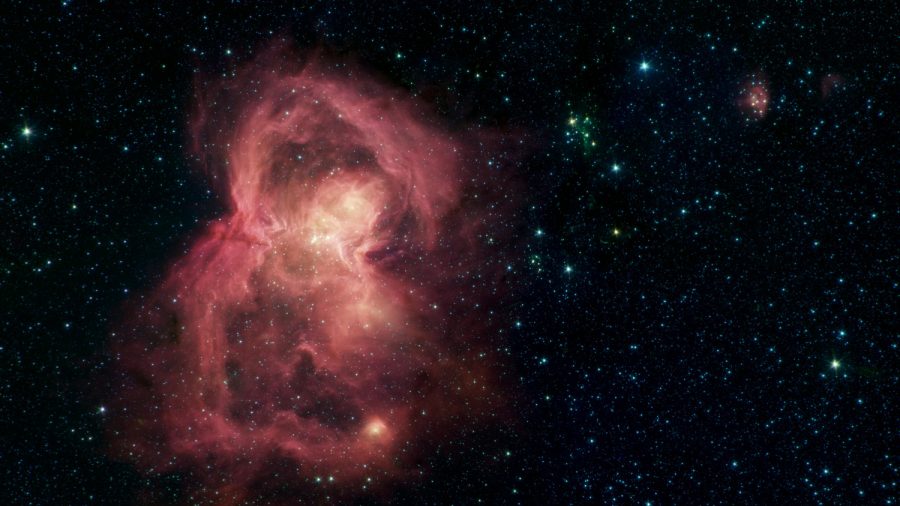No, it doesn’t… ok fine, it has a slight resemblance.
Most people subconsciously think that space nebulas, supernovas, etc., actually appear in those kaleidoscopic of colors to the human eye. But they don’t, this is a picture taken by the Infrared Array Camera (IRAC) installed on The Spitzer telescope, which was launched in 2003.
The composite picture is made up of four different photos taken using different wavelengths of infrared light shown as blue, green, orange, and red, according to NASA.
The Westerhout 40 (W40) nebula is 1,400 lightyears from the Sun, about the same distance as the Orion nebula. This is actually a nursery for cute new baby stars—the center of a star cluster—a hotbed breeding ground. Some of the youngest stars are surrounded by dusty disks of material, which glow with a yellow or red hue in the infrared image.
“Besides being beautiful, W40 exemplifies how the formation of stars results in the destruction of the very clouds that helped create them,” NASA added in its post. “Inside giant clouds of gas and dust in space, the force of gravity pulls material together into dense clumps. Sometimes these clumps reach a critical density that allows stars to form at their cores.”
“The material that forms W40’s wings was ejected from a dense cluster of stars that lies between the wings in the image. The hottest, most massive of these stars, W40 IRS 1a, lies near the center of the star cluster.”
According to Fox, there’s another cluster of stars called “Serpens South” that can be observed at the upper right part of the picture. Being younger than the W40, the Serpens South still has its stars embedded in its clouds but it will sooner or later “break out to produce bubbles like those of W40.”
One comment on Fox’s article said: “This is absolutely ‘beautifly’ Isn’t God grand.”
Harvard Astronomer Claims Space Object May Be Alien Probe
Harvard University Astronomy Department chair Avi Loeb is pushing back against peer criticism of his hypothesis that a strange object—the Oumuamua—found in the solar system might be an alien probe.
“As became apparent from the reaction of some scientists to my publications on the subject, many of them assign a prior probability of zero to the possibility that we will find evidence for alien civilizations,” Loeb wrote in a Reddit “ask me anything” or AMA discussion he initiated on Feb. 2.

Loeb, who is a Professor of Science at Harvard University and chairs the ivy league school’s Department of Astronomy, caused a stir when last November he and colleague Shmuel Bialy published an article in Astrophysical Journal Letters outlining the mind-boggling alien claim.
“Considering an artificial origin, one possibility is that ‘Oumuamua’ is a lightsail, floating in interstellar space as a debris from an advanced technological equipment,” Loeb wrote, adding that evidence suggested that the object “may be a fully operational probe sent intentionally to Earth’s vicinity by an alien civilization.”

One of the questions asked of Loeb on the AMA was whether alien technology might be so advanced and unlike own, that our methods of detecting it simply fall short.
“In your opinion, what is the likelihood that alien life will have formed along a mechanism so different from our own that we will initially overlook it, or potentially already have overlooked it?” a Reddit user asked.
“High. Our imagination is limited to what we know. Our current technology is accelerating exponentially with an e-folding time of a few years. The car I drive now is significantly better than the once I drove three years ago (I had to replace it due to a minor accident last summer). This means that we will not recognize our own technology in a hundred years (30 e-folding times) from now. This also means that civilizations which are a billion years old would be so sophisticated that we might not recognize them with our current detectors.”
Loeb argued in a January article in the Scientific American that just like “Oumuamua could possibly be a message in a bottle from another civilization, swept to our solar system shore,” humans over the next century “will likely develop the ability to send our own technological bottles to the shores of other planetary systems.”
He suggested that such exploratory spacecraft might carry onboard robots equipped with 3-D printers, which could use the raw materials they find in other solar systems to make artificial objects based on blueprints from Earth.

In another Scientific American article titled “6 Strange Facts about the Interstellar Visitor ‘Oumuamua,” Loeb outlined a number of arguments in support of seriously considering whether the space object is alien.
He also made the emphatic claim that in the face of evidence, the truth should be accepted, however strange it may seem. He wrote, “In contemplating the possibility of an artificial origin, we should keep in mind what Sherlock Holmes said: ‘when you have excluded the impossible, whatever remains, however improbable, must be the truth.'”
The Epoch Times reporter Tom Ozimek contributed to this report.


